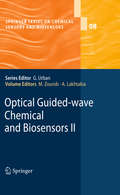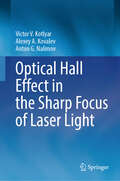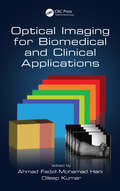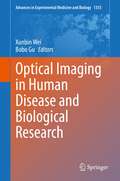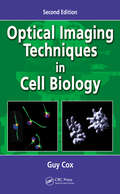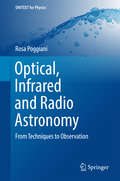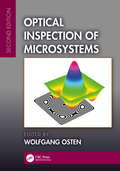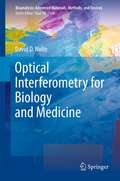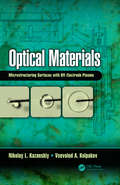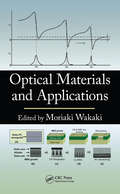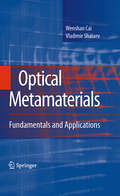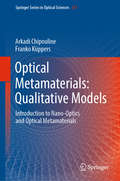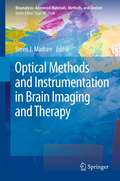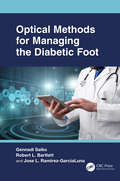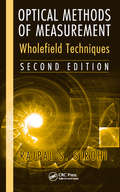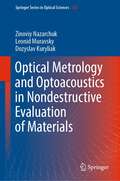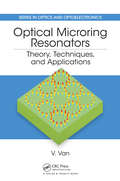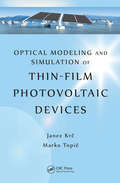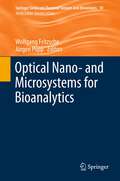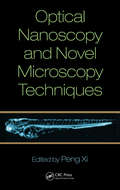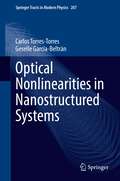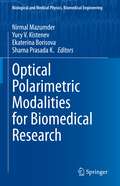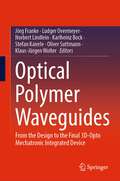- Table View
- List View
Optical Guided-wave Chemical and Biosensors II
by Akhlesh Lakhtakia Mohammed ZourobFor the first time, distinguished scientists from key institutions worldwide provide a comprehensive approach to optical sensing techniques employing the phenomenon of guided wave propagation for chemical and biosensors. This includes both state-of the-art fundamentals and innovative applications of these techniques. The authors present a deep analysis of their particular subjects in a way to address the needs of novice researchers such as graduate students and post-doctoral scholars as well as of established researchers seeking new avenues. Researchers and practitioners who need a solid foundation or reference will find this work invaluable. This second of two volumes covers the incorporation of periodic structures in waveguides to exploit the Bragg phenomenon, optical fiber sensors, hollow waveguides and micro-resonators as well as a review of the tremendous expansion of terahertz technology for sensing applications.
Optical Hall Effect in the Sharp Focus of Laser Light
by Victor V. Kotlyar Alexey A. Kovalev Anton G. NalimovThis book explores the optical Hall effect in the sharp focus of laser light. It builds upon the established theory of Richards-Wolf (1959), providing numerous real-world examples that illustrate both spin and orbital Hall effects near the focal point. Within the focal zone, distinct regions of left and right circular polarization emerge, showcasing the orbital Hall effect. This effect becomes apparent when localized areas within the focal plane experience transverse energy flow, rotating either clockwise or counterclockwise. The spin Hall effect, a fundamental occurrence, is demonstrated when a linearly polarized Gaussian beam is concentrated. Furthermore, the book reveals spin and orbital Hall effects in light fields with nonuniform linear polarization, where the polarization direction varies within the beam cross section. While the optical or photonic Hall effect has been recognized since 2004, a comprehensive monograph detailing its focal dynamics has been lacking until now. Drawing from the cohesive theoretical framework of the Richards-Wolf theory, this book offers specific examples and results from computer modeling. It equips readers with analytical relations for calculating energy and spin fluxes near a sharp focus across various initial light vector fields. Designed for a diverse audience, including scientists, engineers, and students in optics and photonics, this book serves as a valuable resource. It caters to undergraduate and graduate students in applied mathematics, physics, informatics, and optics, and can also benefit researchers and professionals in the field. Moreover, the book holds potential as a foundational text for advanced graduate courses
Optical Imaging and Metrology: Advanced Technologies
by Prof. Dr. Wolfgang Osten Nadya ReingandA comprehensive review of the state of the art and advances in the field, while also outlining the future potential and development trends of optical imaging and optical metrology, an area of fast growth with numerous applications in nanotechnology and nanophysics. Written by the world's leading experts in the field, it fills the gap in the current literature by bridging the fields of optical imaging and metrology, and is the only up-to-date resource in terms of fundamental knowledge, basic concepts, methodologies, applications, and development trends.
Optical Imaging for Biomedical and Clinical Applications
by Ahmad Fadzil Mohamad Hani and Dileep KumarOptical imaging is a rapidly emerging imaging technique that has been successfjully translated into biomedical applications ranging from clinical diagnosis to molecular biology. This book includes an introductory section to explore various optical imaging devices and their functionality and roles for biomedical applications such as dermatology and ophthalmology. Recent developments as exemplified with the authors research are explored in detail. In depth discussion of other disease conditions and their diagnosis with optical imaging techniques are also covered.
Optical Imaging in Human Disease and Biological Research (Advances in Experimental Medicine and Biology #3233)
by Xunbin Wei Bobo GuThe book introduces readers to the basic principle of optical imaging technologies. Focusing on human disease diagnostics using optical imaging methods, it provides essential information for researchers in various fields and discusses the latest trends in optical imaging. In recent decades, there has been a huge increase in imaging technologies and their applications in human diseases diagnostics, including magnetic resonance imaging, x-ray computed tomography, and nuclear tomographic imaging. This book promotes further developments to extend optical imaging to a wider range of disease diagnostics. It is a valuable resource for researchers and students in the field of biomedical optics, as well as for clinicians.
Optical Imaging Techniques in Cell Biology
by Guy CoxOptical Imaging Techniques in Cell Biology, Second Edition covers the field of biological microscopy, from the optics of the microscope to the latest advances in imaging below the traditional resolution limit. It includes the techniques-such as labeling by immunofluorescence and fluorescent proteins-which have revolutionized cell biology. Quantitat
Optical, Infrared and Radio Astronomy
by Rosa PoggianiThis textbook presents the established sciences of optical, infrared, and radio astronomy as distinct research areas, focusing on the science targets and the constraints that they place on instrumentation in the different domains. It aims to bridge the gap between specialized books and practical texts, presenting the state of the art in different techniques. For each type of astronomy, the discussion proceeds from the orders of magnitude for observable quantities that drive the building of instrumentation and the development of advanced techniques. The specific telescopes and detectors are then presented, together with the techniques used to measure fluxes and spectra. Finally, the instruments and their limits are discussed to assist readers in choice of setup, planning and execution of observations, and data reduction. The volume also includes worked examples and problem sets to improve student understanding; tables and figures in chapters summarize the state of the art of instrumentation and techniques.
Optical Inspection of Microsystems, Second Edition
by Wolfgang OstenWhere conventional testing and inspection techniques fail at the microscale, optical techniques provide a fast, robust, noninvasive, and relatively inexpensive alternative for investigating the properties and quality of microsystems. Speed, reliability, and cost are critical factors in the continued scale-up of microsystems technology across many industries, and optical techniques are in a unique position to satisfy modern commercial and industrial demands. Optical Inspection of Microsystems, Second Edition, extends and updates the first comprehensive survey of the most important optical measurement techniques to be successfully used for the inspection of microsystems. Under the guidance of accomplished researcher Wolfgang Osten, expert contributors from industrial and academic institutions around the world share their expertise and experience with techniques such as image processing, image correlation, light scattering, scanning probe microscopy, confocal microscopy, fringe projection, grid and moire techniques, interference microscopy, laser-Doppler vibrometry, digital holography, speckle metrology, spectroscopy, and sensor fusion technologies. They also examine modern approaches to data acquisition and processing, such as the determination of surface features and the estimation of uncertainty of measurement results. The book emphasizes the evaluation of various system properties and considers encapsulated components to increase quality and reliability. Numerous practical examples and illustrations of optical testing reinforce the concepts. Supplying effective tools for increased quality and reliability, this book Provides a comprehensive, up-to-date overview of optical techniques for the measurement and inspection of microsystems Discusses image correlation, displacement and strain measurement, electro-optic holography, and speckle metrology techniques Offers numerous practical examples and illustrations Includes calibration of optical measurement systems for the inspection of MEMS Presents the characterization of dynamics of MEMS
Optical Interferometry for Biology and Medicine
by David D. NolteThis book presents the fundamental physics of optical interferometry as applied to biophysical, biological and medical research. Interference is at the core of many types of optical detection and is a powerful probe of cellular and tissue structure in interfererence microscopy and in optical coherence tomography. It is also the root cause of speckle and other imaging artefacts that limit range and resolution. For biosensor applications, the inherent sensitivity of interferometry enables ultrasensitive detection of molecules in biological samples for medical diagnostics. In this book, emphasis is placed on the physics of light scattering, beginning with the molecular origins of refraction as light propagates through matter, and then treating the stochastic nature of random fields that ultimately dominate optical imaging in cells and tissue. The physics of partial coherence plays a central role in the text, with a focus on coherence detection techniques that allow information to be selectively detected out of incoherent and heterogeneous backgrounds. Optical Interferometry for Biology and Medicine is divided into four sections. The first covers fundamental principles, and the next three move up successive scales, beginning with molecular interferometry (biosensors), moving to cellular interferometry (microscopy), and ending with tissue interferometry (biomedical). An outstanding feature of the book is the clear presentation of the physics, with easy derivations of the appropriate equations, while emphasizing "rules of thumb" that can be applied by experimental researchers to give semi-quantitative predictions.
Optical Materials: Microstructuring Surfaces with Off-Electrode Plasma
by Nikolay L. Kazanskiy Vsevolod A. KolpakovThis reference book concentrates on microstructuring surfaces of optical materials with directed fluxes of off-electrode plasma generated by high-voltage gas discharge and developing methods and equipment related to this technique. It covers theoretical and experimental studies on the electrical and physical properties of high-voltage gas discharges used to generate plasma outside an electrode gap. A new class of methods and devices that makes it possible to implement a series of processes for fabricating diffraction microstructures on large format wafers is also discussed.
Optical Materials and Applications (Optical Science and Engineering #148)
by Wakaki MoriakiThe definition of optical material has expanded in recent years, largely because of IT advances that have led to rapid growth in optoelectronics applications. Helping to explain this evolution, Optical Materials and Applications presents contributions from leading experts who explore the basic concepts of optical materials and the many typical applications in which they are used. An invaluable reference for readers ranging from professionals to technical managers to graduate engineering students, this book covers everything from traditional principles to more cutting-edge topics. It also details recent developmental trends, with a focus on basic optical properties of material. Key topics include: Fundamental optical properties of solids Fundamental optical materials (including thin films) from both linear and nonlinear perspectives Use of bulk materials in the design of various modifications Application of optical thin films in artificial components Formation of artificial structures with sub-wavelength dimensions Use of physical or chemical techniques to control lightwave phase One-, two-, and three-dimensional structures used to control dispersion of materials for nanophotonics Progress of the optical waveguide, which makes optical systems more compact and highly efficient This book carefully balances coverage of theory and application of typical optical materials for ultraviolet, visible and infrared, non-linear optics, solid state lasers, optical waveguides, optical thin films and nanophotonics. It addresses both basic ideas and more advanced topics, making it an equally invaluable resource for beginners and active researchers in this growing field.
Optical Metamaterials
by Wenshan Cai Vladimir ShalaevMetamaterials--artificially structured materials with engineered electromagnetic properties--have enabled unprecedented flexibility in manipulating electromagnetic waves and producing new functionalities. This book details recent advances in the study of optical metamaterials, ranging from fundamental aspects to up-to-date implementations, in one unified treatment. Important recent developments and applications such as superlens and cloaking devices are also treated in detail and made understandable. The planned monograph can serve as a very timely book for both newcomers and advanced researchers in this extremely rapid evolving field.
Optical Metamaterials: Introduction to Nano-Optics and Optical Metamaterials (Springer Series in Optical Sciences #211)
by Franko Küppers Arkadi ChipoulineThis textbook bridges the gap between university courses on electrodynamics and the knowledge needed to successfully address the problem of electrodynamics of metamaterials. It appeals to both experimentalists and theoreticians who are interested in the physical basics of metamaterials and plasmonics. Focusing on qualitative fundamental treatment as opposed to quantitative numerical treatment, it covers the phenomena of artificial magnetization at high frequencies, and discusses homogenization procedures and the basics of quantum dynamics in detail. By considering different phenomena it creates a self-consistent qualitative picture to explain most observable phenomena. This allows readers to develop a better understanding of the concepts, and helps to create a conceptual approach, which is especially important in educational contexts. This clearly written book includes problems and solutions for each chapter, which can be used for seminars and homework, as well as qualitative models that are helpful to students.
Optical Methods and Instrumentation in Brain Imaging and Therapy
by Steen J. MadsenThis book provides a comprehensive up-to-date review of optical approaches used in brain imaging and therapy. It covers a variety of imaging approaches including diffuse optical imaging, laser speckle imaging, photoacoustic imaging and optical coherence tomography. A number of laser-based therapeutic techniques are reviewed, including photodynamic therapy, fluorescence guided resection and photothermal therapy. Fundamental principles and instrumentation are discussed for each imaging and therapeutic approach.
Optical Methods for Managing the Diabetic Foot
by Gennadi Saiko Robert L. Bartlett Jose L. Ramirez-GarciaLunaThis book discusses optical technologies for Diabetic Foot management. It combines the current medical literature review with an overview of the technology and physics behind it. Thus, it is a single-source introduction to the topic. It can also be used as a reference source and practical guide for the use of technology. The particular focus is on low-cost technologies, including hyperspectral imaging, thermography, and endogenous bacterial fluorescence. Moving diagnostic modalities closer to the patient (e.g., primary care) allows the disease to be detected at an earlier stage, thus improving outcomes. However, while some optical technologies are available commercially, they have not received wide clinical adoption due to gaps in knowledge translation to mainstream medicine. This book aims to narrow this gap with practical illustrations. The book will be of interest to a broad range of healthcare professionals, clinical researchers, engineers, and decision-makers, who are dealing with complications of diabetes. Key Features: Reviews the current state of technologies. Provides a practical guide with practical considerations and illustrations. Supplies a 360-degree view of the combination of clinical information with a technology background and primers on physics and engineering.
Optical Methods of Measurement: Wholefield Techniques, Second Edition (Optical Science and Engineering)
by Rajpal SirohiOptical Methods of Measurement: Wholefield Techniques, Second Edition provides a comprehensive collection of wholefield optical measurement techniques for engineering applications. Along with the reorganization of contents, this edition includes a new chapter on optical interference, new material on nondiffracting and singular beams and their applications, and updated bibliography and additional reading sections. The book explores the propagation of laser beams, metrological applications of phase-singular beams, various detectors such as CCD and CMOS devices, and recording materials. It also covers interference, diffraction, and digital fringe pattern measurement techniques, with special emphasis on phase measurement interferometry and algorithms. The remainder of the book focuses on theory, experimental arrangements, and applications of wholefield techniques. The author discusses digital hologram interferometry, digital speckle photography, digital speckle pattern interferometry, Talbot interferometry, and holophotoelasticity. This updated book compiles the major wholefield methods of measurement in one volume. It provides a solid understanding of the techniques by describing the physics behind them. In addition, the examples given illustrate how the techniques solve measurement problems.
Optical Metrology and Optoacoustics in Nondestructive Evaluation of Materials (Springer Series in Optical Sciences #242)
by Zinoviy Nazarchuk Leonid Muravsky Dozyslav KuryliakThis book includes the description, modeling and realization of new optical metrology techniques for technical diagnostics of materials. Special attention is paid to multi-step phase shifting interferometry with arbitrary phase shifts between interferograms, phase shifting and correlation digital speckle pattern interferometry, optical-digital speckle correlation, and digital image correlation, as well as dynamic speckle patterns analysis. Optoacoustic techniques can be treated as a separate branch of optical metrology and can solve many problems of technical diagnostics, including detection and localization of subsurface defects in laminated composite materials. The utility of such techniques can be increased by illumination of the object via acoustic waves at certain frequencies. Hence, an effective theoretical approach to the modeling of an elastic wave field interaction with an interphase defect, and to defect visualization using dynamic speckle patterns, is also included in this book. The experimental proof of the proposed approaches was achieved using a specially created hybrid optical-digital system for detection of different subsurface defects. This book is intended for engineers, researchers and students engaged in the field of nondestructive evaluation of materials and technical diagnostics of structural elements, hybrid optical systems, speckle metrology and optoacoustic imaging techniques.
Optical Microring Resonators: Theory, Techniques, and Applications (Series in Optics and Optoelectronics)
by Vien Van"a detailed, cognizant account of numerous crucial aspects of optical microring resonators" – Amr S. Helmy, Professor of Electrical & Computer Engineering, University of Toronto "an excellent choice for gaining an insight into the vast potential of microring resonators" – Jalil Ali, Professor, Laser Center ISI-SIR, University of Technology, Malaysia "a thorough treatment… appeal[s] to a wide range of audiences" – L. Jay Guo, Professor of Electrical Engineering & Computer Science, The University of Michigan The field of microring resonator research has seen tremendous growth over the past decade, with microring resonators now becoming a ubiquitous element in integrated photonics technology. This book fills the need for a cohesive and comprehensive treatment of the subject, given its importance and the proliferation of new research in the field. The expert author has as an introductory guide for beginners as well as a reference source for more experienced researchers. This book aims to fulfill this need by providing a concise and detailed treatment of the fundamental concepts and theories that underpin the various applications. To appeal to as wide a readership as possible, major areas of applications of microring resonators will also be covered in depth.
Optical Modeling and Simulation of Thin-Film Photovoltaic Devices
by Janez Krc Marko TopicIn wafer-based and thin-film photovoltaic (PV) devices, the management of light is a crucial aspect of optimization since trapping sunlight in active parts of PV devices is essential for efficient energy conversions. Optical modeling and simulation enable efficient analysis and optimization of the optical situation in optoelectronic and PV devices.
Optical Nano- and Microsystems for Bioanalytics
by Jürgen Popp Wolfgang FritzscheThis book describes the state of the art in the field of bioanalytical nano- and microsystems with optical functionality. In 12 chapters distinguished scientists and leaders in their respective fields show how various optical technologies have been miniaturized and integrated over the last few decades in order to be combined with nano- and microsystems for applications in the life sciences. The main detection and characterization technologies are introduced, and examples of the superiority of these integrated approaches compared to traditional ones are provided. Examples from e.g. the fields of optical waveguides, integrated interferometers, surface plasmon resonance or Raman spectroscopy are introduced and discussed, and it is shown how these approaches have led to novel functionalities and thereby novel applications.
Optical Nanoscopy and Novel Microscopy Techniques
by Peng XiMicroscopy is at the forefront of multidisciplinary research. It was developed by physicists, made specific by chemists, and applied by biologists and doctors to better understand how the human body works. For this very reason, the field has been revolutionized in past decades.The objective of Optical Nanoscopy and Novel Microscopy Techniques is to
Optical Nonlinearities in Nanostructured Systems (Springer Tracts in Modern Physics #287)
by Carlos Torres-Torres Geselle García-BeltránThis book provides readers with a detailed overview of second- and third-order nonlinearities in various nanostructures, as well as their potential applications. Interest in the field of nonlinear optics has grown exponentially in recent years and, as a result, there is increasing research on novel nonlinear phenomena and the development of nonlinear photonic devices. Thus, such a book serves as a comprehensive guide for researchers in the field and those seeking to become familiar with it.This text focuses on the nonlinear properties of nanostructured systems that arise as a result of optical wave mixing. The authors present a review of nonlinear optical processes on the nanoscale and provide theoretical descriptions for second and third-order optical nonlinearities in nanostructures such as carbon allotropes, metallic nanostructures, semiconductors, nanocrystals, and complex geometries. Here, the characterization and potential applications of these nanomaterials are also discussed. The factors that determine the nonlinear susceptibility in these systems are identified as well as the influence of physical mechanisms emerging from resonance and off-resonance excitations. In addition, the authors detail the effects driven by important phenomena such as quantum confinement, localized surface plasmon resonance, Fano resonances, bound states, and the Purcell effect on specific nanostructured systems. Readers are provided with a groundwork for future research as well as new perspectives in this growing field.
Optical Physics
by A. LipsonAimed at undergraduate and advanced courses on modern optics, it is ideal for scientists and engineers. The book covers the principles of geometrical and physical optics, leading into quantum optics, using mainly Fourier transforms and linear algebra. Chapters are supplemented with advanced topics and up-to-date applications, exposing readers to key research themes, including negative refractive index, surface plasmon resonance, phase retrieval in crystal diffraction and the Hubble telescope, photonic crystals, super-resolved imaging in biology, electromagnetically induced transparency, slow light and superluminal propagation, entangled photons and solar energy collectors. Solutions to the problems, simulation programs, key figures and further discussions of several topics are available at www.cambridge.org/lipson.
Optical Polarimetric Modalities for Biomedical Research (Biological and Medical Physics, Biomedical Engineering)
by Nirmal Mazumder Yury V. Kistenev Ekaterina Borisova Shama Prasada K.This book focuses on polarization microscopy, a powerful optical tool used to study anisotropic properties in biomolecules, and its enormous potential to improve diagnostic tools for various biomedical research. The interaction of polarized light with normal and abnormal regions of tissue reveals structural information associated with its pathological condition. Diagnosis using conventional microscopy can be time-consuming, as pathologists require an hour to freeze and stain tissue slices from suspected patients. In comparison, polarization microscopy more quickly distinguishes abnormal tissue and provides better microstructural information of samples, even in the absence of staining. This book provides a basic understanding of the properties of polarized light, a description of the polarization microscope, and a mathematical formalism of Mueller matrix polarimetry. The authors discuss various advanced linear and nonlinear optical techniques such as optical coherence tomography (OCT), reflectance and transmission spectroscopy, fluorescence, multiphoton excitation, second harmonic generation, Raman microscopy, and more. They explore the exciting potential of integrating polarimetry with these techniques for possible applications in different areas of biomedical research, as well as the associated challenges. Including the most recent developments on the topic, this book serves as a modern guide to polarization microscopy and advancements in its use in biomedical research.
Optical Polymer Waveguides: From the Design to the Final 3D-Opto Mechatronic Integrated Device
by Jörg Franke Ludger Overmeyer Norbert Lindlein Karlheinz Bock Stefan Kaierle Oliver Suttmann Klaus-Jürgen WolterLight signals in optical waveguides can be used to transmit very large amounts of data quickly and largely without interference. In the industrial and infrastructural sectors, e.g. in the automotive and aerospace industries, the demand to further exploit this potential is therefore increasing. Which technologies can be used to effectively integrate systems that transmit data by means of light into existing components? This is a central question for current research. So far, there have been some technical limitations in this regard. For example, it is difficult to couple the signal of an optical waveguide to other optical waveguides without interruption. There is also a lack of suitable fabrication technologies for three-dimensional waveguides, as well as design and simulation environments for 3D opto-MID. This book addresses these and other challenges.
